As time went on, we made more works, some of them real collaborations. We designed smaller rooms with itsy-bitsy figures and somewhat larger ones. None of them told clear stories. They were all as murky as dreams. I thought up one called Guns and Cleavage for a three-by-four-foot room. We used bits and pieces of images from kung fu, blaxploitation, and old Westerns. We added some shots from Japanese pink movies, and Russ Meyer stills to cover the walls, floor, and ceiling. White or black or yellow, tits, ass, and firearms fuel the movies. BANG, BANG, STAB, SLASH, BOOM, CRASH. I cut down the pictures to their essences — six-shooters blazing, automatic weapons cradled like babies in male arms with burgeoning biceps, Elizabeth Taylor’s cleavage in Cleopatra , but also the built-up boobs or buttocks of starlets. Some of the fragments were cut so small they became abstract. Lying on the floor of this sex-and-violence burlesque are two little brown kids in pajamas with feet, both protectively holding their crotches. (Made me think of me and Letty.)
The Bandage House was another collaboration. We took a small, crooked house with miserable pieces of furniture in it that Harry had built and covered it with torn white gauze, inside and out, but through the material you can see on the walls and floors and the roof discolorations and marks that make you think of bruises, scrapes, wounds, and scars. At first we had some farblondzhet little folks inside it, but we took them out. It had to be empty.
Countless cocktail parties and openings later, we landed a show at the Alex Begley Gallery. When The Suffocation Rooms were shown, they were read through me — P. Q. Eldridge was exploring his identity in his art. White boys, the Anton Tishes of the world, have no need to explore their identities, of course. What is there to explore? They are the neutral universal entity, the unhyphenated humans. I was pretty much all hyphen.
There was a further reading, however. The show was mounted the spring after New York was attacked, and the little mutant that crawled out of the box had the haunting look of a damaged survivor or a new being born in the wreckage. It didn’t matter that the work had been finished well before 9/11. The increasing heat in the rooms contributed to the interpretation; the last, hot room felt ominous. At the same time, my debut was an insignificant casualty of the falling towers. There were a few articles, mostly good notices, but the show was probably even more marginal than it might have been. By the time the rooms were truly recognized, it was too late for Harry.
But back then, she watched it all. She told me that Anton had called her his fairy godmother, and she was mine, too, I suppose. She stood in the corner wearing a hat and watched the spectacle she had made unfold before her. A white, half-Jewish woman became a black, gay, male artist of some small notice, causing a little stir among sophisticated black and/or gay or both people, but white heterosexual people, too. Without the latter it’s back to a ghetto, an art ghetto, but a ghetto nevertheless. I did not give up my job as H/Lester, but I stopped working five days a week and cut down to three. The show’s audience had grown because art world types had started to drift in to see the fighting, dancing, dueling duo. It’s all a vanity fair.
No one saw it then, but Harry and I recorded our story in full on the wallpaper of The Suffocation Rooms . We mixed in the narrative of P.Q. as Harry’s mask with automatic writing, scribbles, doodles, and some palimpsest effects — writing over what we had written — but it’s all there. Unread for years. Phineas Q. Eldridge is really Harriet Burden was written on the walls in several places. P.Q.E. = H.B. Harry described the phenomenon as “inattentional blindness.” She read a lot of science papers, but what it meant was simple: People don’t see things that are right in front of their eyes unless they pay attention to them. That’s how magic works — sleight-of-hand tricks, for example. Harry was ready to tell the world, but nobody was ready for her confession.
One night I heard her crying on Bruno. They were in her bedroom, but her sobs were loud. Then came his hush-hush, it’s-okay voice. Bruno didn’t like the experiment at all. They had verbal knockdowns over it. But I disagreed. I wasn’t an art expert then, and I’m not one now, but I defend our act, if that’s what you want to call it. To be really seen, Harry had to be invisible. It’s Harry crawling out of that box — thin-skinned, part girl/part boy little Harriet-Harry. I knew that. It’s a self-portrait.
Why some artworks create such a big fuss is a conundrum. First the idea spreads like a cold and then people spend money on it. Mine-is-bigger-than-yours goes a long way among collectors in that world, maybe in every world. I never knew Rune — that one-name-only artist — who agreed to be Harry’s third pseudonym. I first saw the art world glamour-puss at the Reim Gallery. I think that’s where Harry first ran into him, too, although I’ve heard several versions of their first meeting, and I could be wrong. I’d read about him on Page Six in the Post , knew he had made it big, but the only works I’d seen were the crosses. He churned out one after another. They resembled the Red Cross sign but were multicolored in flat acrylic. A yellow one had sold for a mint because he had made only one. You can say whatever you want about something so simple, build it up or tear it down, but Rune promoted the Christian symbol as pop icon, as another hot commodity on the art market. The congregants back home at Calvary Pentecostal might have cried blasphemy, but it’s unlikely they’ll ever hear about Rune’s paintings. Fame is a relative term.
Rune had it . Whatever it is, it’s something you can feel in a room, an animal verve, a slink with some sex in it, but it wasn’t personal sex. He was not seducing anyone. He was seducing everyone, and there’s a big difference. I am a student of personal presentation, and it is wildly important to appear careless if not indifferent to the opinions of other people. Even a hint of desperation is ugly, and we must avoid it at all costs. Misery sucks up energy in the person who feels it and in all those who are forced to look at it, and then we’re all stuck in the mud. Desire functions best when it’s directed at a beautiful blank — the boys and girls into whom we toss all our pathetic hopes for happiness. In many ways, Rune was a perfect third candidate for Harry. He arrived with ready-made aura, that mysterious quality that infects our eyes so we can’t tell what we’re looking at anymore. Is the emperor naked or am I a fool? Some hated Rune’s work and others loved it, but no one disputed his power to sway. I don’t know how Harry talked him into becoming a front. He had all the markers of success, a palace-size apartment on Greenwich Street, a house in the Hamptons, and legions of women running marathons after him. Maybe he was bored. Maybe something happened to him after September 11 that made him want what Harry had — her passion, her seriousness, her capacity for joy. I don’t know.
I have a clear memory of Harry and Rune, heads together in the gallery, talking. They were about the same height. I studied him from behind — short blond hair, big shoulders and upper back, narrow hips and a small, hard, slightly flat posterior, long legs in jeans, black boots with heels. And when I moved around to see his face, I noticed he had some wrinkles around his eyes, not so young anymore, but handsome, photogenic. He had a beautiful young woman with him. The two of them looked more like movie stars than movie stars look when you actually see them. She had that slick shine to her that comes from knowing everybody’s looking at you all the time, the pose held for a camera that isn’t there.
Читать дальше












